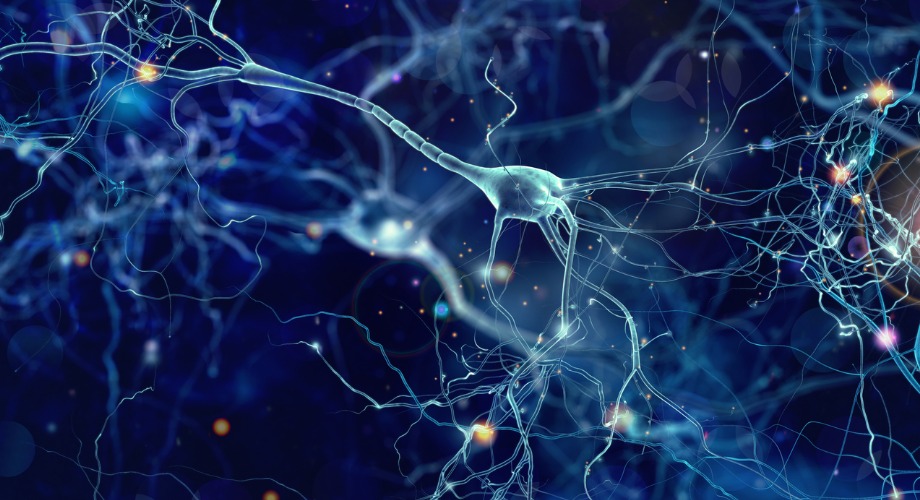
Illustration of neuron cells. A new study provides insights into the molecular events that lead to the destruction of brain cells in Huntington’s disease. (Stock image.)
Huntington’s disease progression involves DNA damage sensor
Abnormal cellular housekeeping and inflammation point to potential target for treating fatal neurodegenerative disorder.
June 26, 2020
JUPITER, FL — Families afflicted by Huntington’s disease face anguishing challenges. An incurable genetic disease, Huntington’s symptoms usually appear after age 30, meaning parents often pass the mutant Huntington’s gene to their children—even grandchildren—before they discover they are carriers. Striking in the prime of life, it damages movement control, mood stability and thinking before ultimately causing death. At least 30,000 people in the United States live with the diagnosis.
“So far there has been no effective therapy available for the disease because we haven’t yet understood the molecular mechanism, even though we know the faulty gene,” says neuroscientist Srinivasa Subramaniam, PhD, associate professor at Scripps Research in Florida.
A new study from Subramaniam and his team provides new insights into the molecular events that lead to the progressive destruction of brain cells in Huntington’s. The research reveals a central role for a damage-sensing enzyme called cGAS that seems to ignite a cascade of inflammation and excessive cellular housekeeping, a process called autophagy. Their study, appearing in the Proceedings of the National Academy of Sciences, raises the possibility that reducing cGAS activity in the brain may be a treatment strategy worth testing in further studies, Subramaniam says.
“The lack of an effective treatment is very frustrating for patients and their families—but we hope that this new study brings us closer to an understanding of the mechanism and eventual development of such a treatment,” says Subramaniam, who has been doing Huntington’s research for 15 years.
Subramaniam and his colleagues discovered that the cGAS enzyme is produced at abnormally high levels in Huntington’s-mutant neurons from the striatum, the brain region that is hit earliest and hardest by Huntington’s disease. The team also found that the high levels of cGAS in striatal Huntington’s neurons drives inflammatory processes in these cells as well as a related cellular waste-removal process called autophagy. Both inflammation and autophagy were known to occur excessively or otherwise abnormally in Huntington’s and have been suspected of contributing to the neuronal destruction that underlies the disease.
The cGAS enzyme has been known as a “DNA sensor” that switches on inflammation and autophagy when it detects damaged DNA in a cell, or foreign DNA such as from a virus. Subramaniam and colleagues found evidence in their study that striatal neurons with the Huntington’s mutation often contain numerous fragments of DNA in the main part of the cell, outside the nucleus where DNA normally is housed. These DNA “micronuclei,” as the researchers call them, are not present in healthy striatal neurons.
The findings suggest that the Huntington’s disease process is leading to the appearance of DNA micronuclei in the cytoplasm of striatal neurons; these pieces of stray DNA activate cGAS—which in turn triggers abnormal, cell-harming inflammation and autophagy.
The scientists now plan to test this hypothesis by reducing cGAS activity with drug-like molecules or genetic engineering in animal models of Huntington’s disease, to see if that slows the progression of the disease. If cGAS-reduction proves safe and beneficial in such models, it could point to the usefulness of treatment strategies that target that signaling pathway.
“We’ll need to follow up with further study, but our linking of cGAS to inflammation and autophagy in Huntington’s striatal neurons suggests that it is a good target for further research as a potential Huntington’s drug target,” Subramaniam says.
“Cyclic GMP-AMP Synthase Promotes the Inflammatory and Autophagy Responses in Huntington Disease,” was written by Manish Sharma, Sumitha Rajendra Rao, Neelam Shahani, Uri Nimrod Ramirez Jarquin, and Srinivasa Subramaniam, all of Scripps Research at the time of the study.
Funding was provided by the National Institute of Neurological Disorders and Stroke (R01-NS087019-01A1, R01-NS094577-01A1), the Cure Huntington Disease Initiative (CHDI), and the Community Foundation for Palm Beach and Martin Counties.
For more information, contact press@scripps.edu

